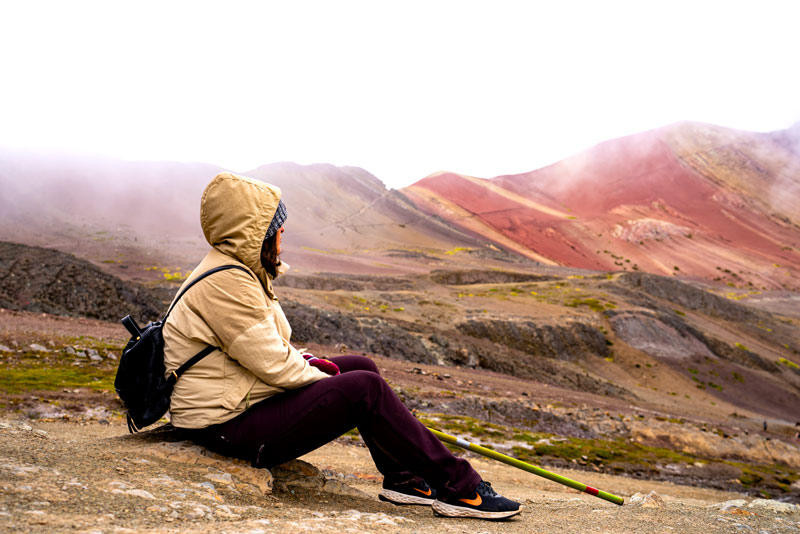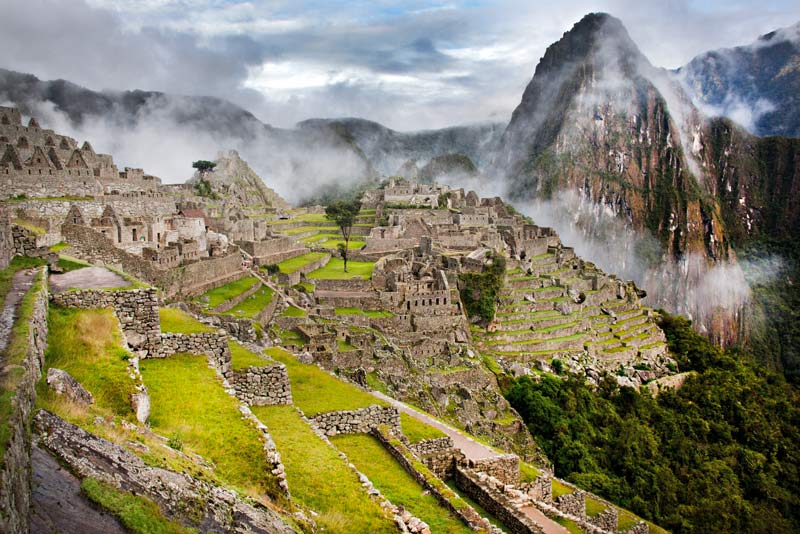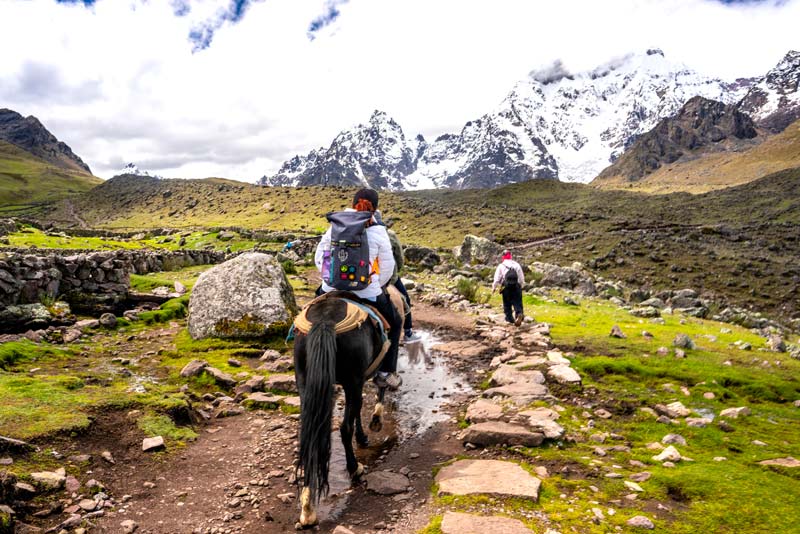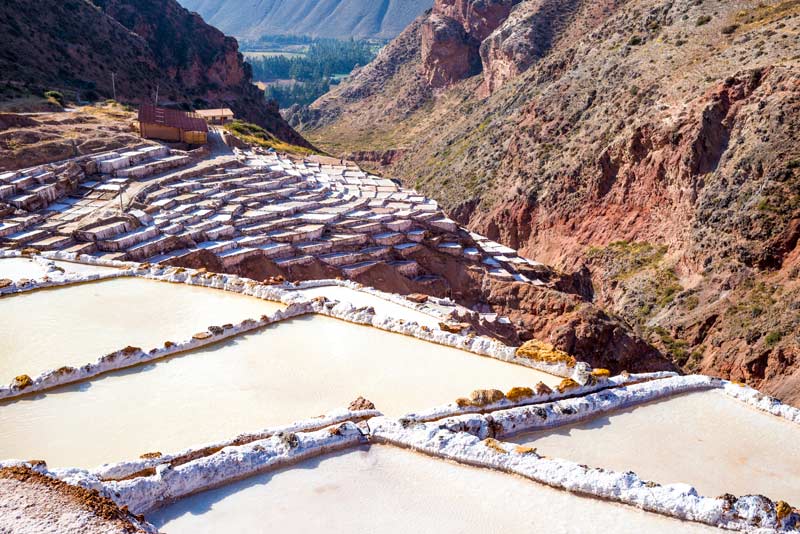The best landscapes to visit in Cusco
The diversity of the landscapes shows us the potential they have to captivate us, inspiring us with their beauty. On your visit to Cusco, surprise is guaranteed; every street, every town, every place is framed so that you will never stop being dazzled. If you want to explore it and see the best landscapes, don’t miss the following destinations where you will make your trip to Cusco an unforgettable memory.
- Rainbow Mountain
- Machu Picchu
- Sacred Valley
- Ausangate snowy Mountain
- Humantay Lagoon
- Maras
- Moray
- Sacsayhuaman
- Huchuy Qosqo
- Choquequirao
- Comparison of destinations
- Recommendations to enjoy the landscapes to the fullest
- Frequently asked questions
Rainbow Mountain
The rainbow mountain, known as Vinicunca or rainbow mountain, is characterized by its layers of minerals that generate bands of colors in shades of red, yellow, green and blue. It is located more than 5,000 meters above sea level, which implies a challenge to reach it, but its majesty full of beautiful landscapes will make it worth it.
The best time to visit and admire all its incredible colors is at midday, when the sunlight makes the view look like a dream.
- Minimum requirements: Given the altitude (above 5,000 meters) it is essential to acclimatize beforehand and have adequate equipment (warm clothing, suitable shoes and sun protection).
- Location: Pitumarca District (Canchis Province).
Discover Cusco on foot
We invite you to explore Cusco on foot and get to know its tourist destinations up close. Exploring the region on foot allows you to directly appreciate the beauty and history of each place, as well as being a healthy and enriching activity. During your tour you can visit the Rainbow Mountain, where you will observe unique natural formations; explore Machu Picchu, to see the Inca architecture in detail; and walk through the Sacred Valley, where you will have the opportunity to learn about local life, its markets and traditional agriculture.
Machu Picchu
Machu Picchu is one of the most important and renowned archaeological sites in the world. It is characterized not only by its impressive construction, but also by the landscapes it houses, every corner is an opportunity to surprise you, combining biodiversity with its architecture makes it a paradise.
Morning light is ideal for taking photos, as the light fog and soft light help to highlight all the details that make this destination unmissable. We recommend arriving early to avoid crowds and capture images from all angles.
- Tip: Travel to Machu Picchu via the Inca Trail to find yourself on a journey immersed in nature and landscapes, you will enjoy the Inca legacy from the heart of its history.
- Location: Aguas Calientes District (Urubamba Province).
Sacred Valley
The Sacred Valley of the Incas is made up of a series of communities, fields and archaeological sites. Towns such as Pisac, Ollantaytambo and Chinchero are part of this area, where the interaction between the Inca heritage and modern rural life can be observed.
In the valley we can see agricultural terraces, rivers and ancient buildings, which allows us to capture different cultural and natural aspects. The place became an ideal place to spend your time in Cusco, since every day you can do different activities immersing yourself in the local culture and its incredible landscapes.
- Tip: It is important to visit each town, so as not to miss out on why the Incas considered this valley sacred.
- Location: It extends from Pisac to Ollantaytambo, following the Urubamba River.
Ausangate snowy Mountain
The Ausangate snow-capped mountain is a mountain that is over 6,000 meters high. It is a popular destination for hiking enthusiasts. The route to Ausangate extends over several days and crosses different ecosystems, allowing visitors to observe the diversity of flora and fauna that adapts to extreme conditions. It is an adventure that will amaze you at every step.
Travelers who embark on this route must be well prepared, as they face very low temperatures and sudden changes in the weather, which makes it essential to have mountain equipment and, preferably, the company of a guide for greater safety.
- Tip: The route extends over 5 days, so consider bringing a notebook to write down your impressions of this adventure so you don’t miss any details.
- Location: Vilcanota Mountain Range (Quispicanchi Province).
Humantay Lagoon
The Humantay Lagoon is a glacial body of water located at an altitude of more than 4,600 meters, which stands out for its turquoise water and the clarity with which it reflects the mountainous surroundings.
Walking the path to Humantay allows you to enjoy a unique experience, where the hike, although demanding, rewards you with views of a lagoon that seems almost perfect in its shape and color. Visiting this place invites you to stop and observe the interaction between water, mountains and daylight, resulting in a visual experience that few other areas of Cusco can offer you. It is a destination that encourages you to appreciate the tranquility of a natural environment and capture in photographs the details that make Humantay a magical place.
- Tip: The journey to the lagoon requires a walk that can last more than two hours, so it is essential to bring plenty of water and food to recover the energy you are losing.
- Location: Route to the snow-capped Salkantay (Anta Province).
Maras
Maras is famous for its salt mines, where salt is extracted in a traditional way. What makes this place so special is the order and organization of the salt terraces, which blend harmoniously with the mountainous landscape of the region. A visit to Maras invites you to observe the ancestral production methods up close, to understand the importance of salt in the local culture and to enjoy a landscape that, due to its contrast of colors and textures, is enchanting.
- Tip: Live the full experience and buy the salts extracted from this magical place, you will appreciate its flavor full of history.
- Location: Maras Community (Sacred Valley).
Moray
Moray is an archaeological site where you can enjoy the view of circular terraces arranged on several levels. This place was used in the Inca era as an agricultural field to experiment with crops in different microclimates. Touring Moray allows you to appreciate the engineering and planning that the Incas applied to make the most of natural resources in difficult terrain. The structure of Moray is especially interesting because it clearly shows how different climatic conditions could be simulated in the same space.
- Tip: Visiting Moray also involves a tour of the Maras salt mines, so taking this trip is an opportunity to be dazzled by two places full of surprises.
- Location: Maras Community (Sacred Valley).
Sacsayhuaman
Sacsayhuamán is an archaeological complex located on the outskirts of the city of Cusco, famous for its enormous stone blocks. Every corner of this place is charged with ancestral energy, so just by seeing it you immerse yourself in a unique atmosphere. Being in a place of high altitude you will be able to appreciate the majesty of the city of Cusco while you tour one of the most emblematic places.
- Location: 2 km from Cusco’s Plaza de Armas. You can get there by walking uphill.
Huchuy Qosqo
Huchuy Qosqo is a lesser-known, but equally fascinating archaeological site that offers an authentic experience away from the most popular tourist routes. This ancient Inca settlement is located in a mountainous environment of the sacred valley, allowing you to immerse yourself in a landscape where history and tradition come to life. The citadel of Huchuy Qosqo, combined with trails that pass through traditional villages and Andean fields, offer a panorama full of history and beauty.
The tranquility of the place makes Huchuy Qosqo a perfect destination for those looking to explore unique landscapes without the hustle and bustle of the most visited sites. It is a place where history can be felt in every corner and where nature is presented in its most majestic state.
- Tip: Consider hiring a local guide to learn more about the history and legends surrounding this place, and make the most of your experience in this hidden corner of Cusco.
- Location: Lamay Village (Sacred Valley)
Choquequirao
Choquequirao is one of the most impressive treasures of the Inca empire, often compared to Machu Picchu for its mysticism and architecture. Located in a difficult-to-access area, this citadel extends into a landscape of mountains and deep valleys, giving it an aura of mystery and adventure. The difficulty of reaching Choquequirao adds a special value to the experience, as each step in the arduous hike rewards you with stunning panoramic views and direct contact with nature.
The sense of isolation makes Choquequirao an ideal destination for adventurers and those seeking an authentic experience away from the conventional tourist routes. The hike through little-explored paths invites you to discover ancient secrets, while the majesty of the Inca archaeological complex connects you with its cultural legacy.
- Tip: The hike to Choquequirao is one of the most demanding in Cusco, so to do it you must be in good physical condition. Preparing to do it will result in one of the best experiences in your life.
- Location: Santa Teresa District (La Convención Province).
At Choquequirao, less than 40% of the citadel has been excavated so far. This means that much of its secrets still remain hidden beneath the vegetation, waiting to be discovered. In addition, this site receives significantly fewer visitors compared to Machu Picchu, giving you the opportunity to explore an equally majestic place, but practically in solitude, surrounded only by imposing nature. It’s like travelling back in time to an unexplored corner of Incan history.
Comparison of destinations
| Destination | Main Features | Accessibility | Travel time | Experience |
|---|---|---|---|---|
| Rainbow Mountain | Mountain full of vibrant colors and dreamlike landscapes. | Access via a medium difficulty hike. | Walk of approximately 4-5 hours round trip. | Adventure and photography. |
| Sacred Valley | Fusion of nature, Inca architecture, Andean culture and traditions. | Ideal for touring by car. | The usual tour takes about a full day. | Culture and nature. |
| Ausangate Snowy Mountain | Snow-capped mountain with glaciers and high mountain hiking trails, imbued with spirituality. | Exclusive access via a high mountain hike, requiring good physical condition and experience at altitude. | Multi-day expedition (approximately 4-5 days). | Extreme adventure and hiking. |
| Humantay Lagoon | Turquoise lagoon surrounded by snow-capped mountains that creates a fairy-tale setting. | Access via a moderate walk. | Walk of approximately 3-4 hours round trip. | Adventure and relaxation. |
| Sacsayhuaman | Inca fortress made of huge stone blocks with panoramic views over the city of Cusco. | Easy access by vehicle to the surrounding area. | Visit of approximately 2-3 hours. | Cultural, historical and scenic. |
| Huchuy Qosqo | Inca archaeological complex in a mountainous environment. | Access via a somewhat demanding hike. | Half-day trip, although it is a recommended place for camping. | Cultural and adventurous. |
| Choquequirao | Inca city, remote and mysterious, whose difficult accessibility intensifies the experience. | Exclusive access via an extended hike on challenging terrain. | Multi-day expedition (approximately 4-5 days of hiking). | Extreme and cultural adventure. |
Recommendations to enjoy the landscapes to the fullest
- Plan ahead: Research each destination, its visiting hours, and book tickets or tours. This will help you avoid setbacks and make the most of your time.
- Acclimatization: Many of these destinations are at high altitudes and require hiking. Acclimatize yourself properly and do some pre-hiking exercises to make the trek more comfortable.
- Hydration and nutrition: Stay well hydrated during the excursion and bring energy-rich snacks or light foods.
- Respect for nature and culture: Take care of the natural environment, do not leave waste and respect local traditions and customs. This guarantees the conservation of these spaces for future generations.
- Hire a tour or guide service: In some places, especially in lesser-known or hard-to-reach areas, a guide will help you learn about the history and details that you might otherwise miss.
- Take advantage of the best hours: Plan your visits during sunrise or sunset, when the light creates a magical atmosphere and enhances the colors and textures of the landscape.
- Know the weather conditions: Check the weather forecast before you leave and have a backup plan ready in case of bad weather. This will allow you to adjust your itinerary and ensure a safe experience.
- Be patient and enjoy the moment: Take your time to contemplate every detail. Sometimes, it’s best to stop, breathe and let yourself be amazed by the beauty of your surroundings.
Frequently asked questions
1) What is the best time to visit Cusco destinations?
The dry season, from May to September, is ideal for outdoor activities and hiking, as weather conditions are more stable and the risk of rain is minimized.
2) What level of fitness do I need to visit these destinations?
Many destinations require moderate physical fitness, as they involve hiking at high altitudes. While places like Machu Picchu are more accessible with train transportation and guided tours, others like Choquequirao or Nevado Ausangate require considerable physical effort.
3) What equipment and clothing should I bring to enjoy these landscapes?
It is essential to dress warmly to adapt to the temperature changes. It is recommended to bring several layers of clothing, suitable hiking shoes, sunscreen, water and snacks.
4) Do I need to reserve tickets or special permits for any of these destinations?
Yes, especially for iconic sites like Machu Picchu, where advance ticket booking is a must. Other destinations, particularly those involving hiking, may require permits.
5) How can I avoid altitude sickness during excursions?
Proper acclimatization is key: spend a few days in Cusco before starting intense activities, stay hydrated, get enough rest, and, if necessary, consult a doctor for preventive medication recommendations.
6) Is it safe to visit these destinations?
Yes, as long as you follow safety recommendations, acclimatize properly and are prepared for the terrain and weather conditions. For more demanding hikes, a tour or guide service is highly recommended.
7) What environmental conservation measures should I take into account?
It is essential to respect nature and cultural heritage, do not leave waste, follow the instructions of the guides, maintain responsible behavior and collaborate in the preservation of these spaces so that future generations can enjoy them.
8) What do I do if I feel uncomfortable with the altitude?
Rest, drink plenty of water and try to relax. You can also drink coca tea, which is usually a recommended option.
Advice from people who have been there
 By: Luis Z.
By: Luis Z.“Hike through Huchuy Qosqo“
“As a visitor to Huchuy Qosqo, I can say that this place connects you in a very special way with Andean history and culture. The experience was unique: walking among ruins that still preserve the Inca essence made me feel as if I were stepping back in time, in a mountainous and quiet environment that contrasts with the most crowded tourist sites. The authenticity of the place, the warmth of the local community and the peace you breathe make every step worthwhile.“
By Ticket Machu Picchu – Last updated, March 10, 2025




